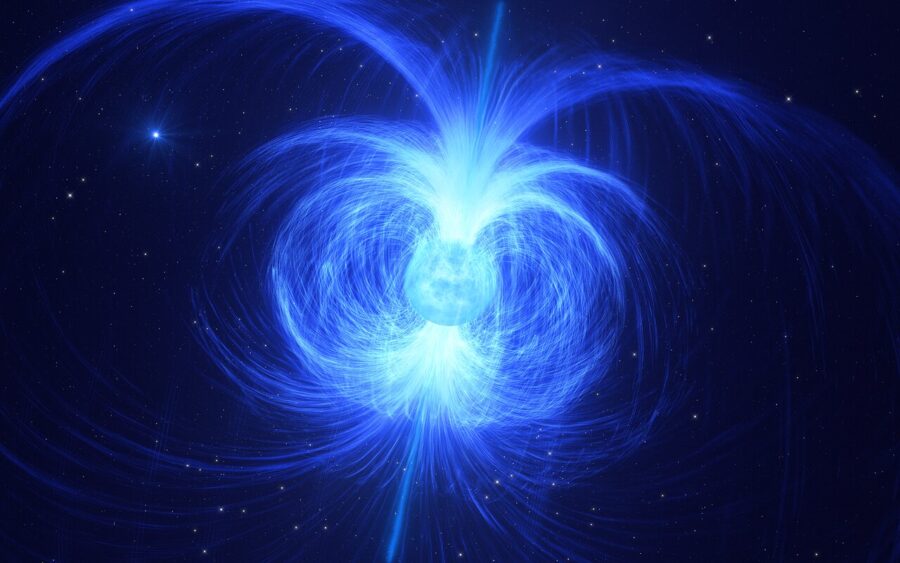Astronomers have found a star that has a magnetic field rivaling the strongest magnet humans have ever built — and it might explain the origin of highly magnetic cinders known as magnetars.

ESO / L. Calçada
There’s an odd star 3,300 light-years away in the southern constellation of Monoceros, the Unicorn. On the surface, it’s an unremarkable 10th-magnitude dot of light. But underneath, there’s a mess of contradictions.
“This star became a bit of an obsession of mine,” says Tomer Shenar (University of Amsterdam), who led a study on it published in Science.
The star, known as HD 45166, appears to be in the Wolf-Rayet class, which consist of helium-dominated stars blowing away massive winds. These winds leave a distinctive signature in the star’s spectrum. However, while most Wolf-Rayet stars hold more than eight Suns’ worth of mass, this one weighs in at much less than that. Moreover, it’s weirdly faint.
Astronomers previously solved these conundrums by suggesting that this peculiar star might have formed via a collision of two lower-mass stars. But if that were the case, then this merger shouldn’t be producing a wind at all — and its spectrum says it definitely is. The contradiction is weird enough that the star isn’t even included in a galactic catalog of Wolf-Rayet stars, despite its Wolf-Rayet spectrum.
Shenar and his colleagues looked at this star anew after an exhaustive investigation involving decades of data from many different instruments on multiple telescopes. They wanted to answer the question: Is this star magnetic?
Every star has a magnetic field to some extent. Stars are made of churning plasma — that is, of moving bits of electrically charged particles — and that movement creates a magnetic field. Magnetism can lead to activity such as prominences or eruptions, as we see from the Sun. But most stars actually aren’t that magnetic. An average area on the Sun has a field about 1 Gauss, about twice the strength of Earth’s surface field.
Some stars, though, have much more powerful fields. The cinders of burnt-out massive stars known as neutron stars have magnetic fields 1 trillion times stronger than the Sun’s. As the massive star collapses, its magnetic field lines are packed into a much tighter space, and the field strength increases. But then there are magnetars: These neutron stars have fields 1,000 times stronger again than regular neutron stars and, given that most stars aren’t all that magnetic to begin with, those are more difficult to explain.
That brings us to the curious case of HD 45166. Shenar’s team used an instrument on the Canada-France-Hawaii Telescope to look for the chemical fingerprints that magnetic fields can leave on a star’s spectrum. What they found made it crystal clear: This star isn’t just a little magnetic — its field strength is a whopping 43,000 Gauss. “One-thousand-Gauss magnetic fields are pretty rare amongst massive stars, so 43,000 Gauss is really off the chart,” says Paul Crowther (University of Sheffield, UK), who was not involved in the study.
The team didn’t stop there. They also re-analyzed other data on the star’s brightness and motion. Astronomers had previously estimated its mass to be 4 times the Sun’s, determined by watching its orbit around a relatively ordinary blue star. The light from both stars brightens and fades every 1½ days, and astronomers had thought that came from the orbit of the two stars around each other.
But Shenar’s team realized these pulsations actually come from the 100 million-year-old companion. After pulling motion data that span 24 years, they found that the actual orbital period is measured not in days but in years: 22 years to be exact, with the two stars as far apart as Saturn is from the Sun.
With this new understanding, the magnetic star becomes even less massive than previously thought, with only 2 solar masses. The smaller mass means there’s no other option that explains this star’s origin: It can only have come from the merger of two smaller stars.
“A merger of two stars can induce a strong magnetic field,” Shenar says, citing previous work. “The stars do not need to be magnetic prior to the merger.”
But such a diminutive star shouldn’t produce such a strong wind, so why do we see the signature of one? The powerful magnetic field is key, trapping outflowing material and thus strengthening the weak wind’s spectroscopic fingerprint.
“This paper resolves a long-standing puzzle about HD 45166 since it has been recognized as an oddity amongst Wolf-Rayet stars,” Crowther says. The “colossal” magnetic field, he adds, ties together the disparate pieces into a single origin story.
Eventually, Shenar and his colleagues estimate that this star will collapse into a neutron star, and its magnetic field will strengthen as it does so. They think this will create a magnetar; however, Crowther isn’t sure of the star’s destiny. “Lots of complex physics happens during a supernova explosion,” he says.
One way to investigate the chance of that happening is to find more such objects, Shenar says. “HD 45166 is ‘only’ 3,300 light-years away,” he notes. “Our Milky Way Galaxy likely contains thousands more. Now that we know how they look like, there's a good chance of finding more of these magnetic monsters.”
So the question becomes not why is this star so weird, but rather how weird is it — weird enough that there are any others like it?
 0
0









Comments
You must be logged in to post a comment.